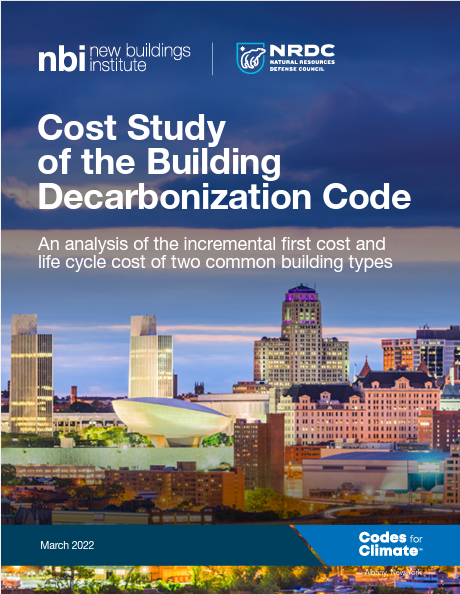Building Decarbonization Code
Guideline / August 26, 2021 / Codes And Policy / Energy Codes

The Building Decarbonization Code is a groundbreaking tool aiming to deliver carbon neutral performance. The Version 1.2 code language from NBI serves as a building decarbonization overlay to the 2021 International Energy Conservation Code (IECC) and is now compatible with ASHRAE 90.1. It is designed to help states and cities working to mitigate carbon resulting from energy use in the built environment, which accounts for 39% of U.S. emissions. It also offers market insight into rules that will determine how new buildings are designed and constructed in the future in order to curb the worst impacts of climate change.
The overlay is focused on codes for new construction with the potential of adding code language for existing buildings in a future version. While not an all-electric code, the language does prioritize efficient electric equipment and is designed to be flexible. Sections cover All-Electric and Mixed-Fuel options for residential and commercial construction. We have provided a comprehensive PDF document via the download link below, Word documents of the code provisions are available upon email request to [email protected].
Additional Resources
Cost Study of the Building Decarbonization Code
This report analyzes the incremental first cost and life cycle cost of two common building types that follow the code language in NBI’s Building Decarbonization Code. The study, supported by the Natural Resources Defense Council (NRDC), analyzes first costs for both all-electric and mixed-fuel paths for single-family and medium office prototypes. It also includes life cycle cost analysis for the single-family scenario. Researchers used cost data from New York State, a relatively expensive market, in colder Climate Zone 5A.
Access the Cost Study of the Building Decarbonization Code

Residential and Commercial Decarbonization Factsheets
Also in the Code are solutions to inclusion of key electrification technologies like solar energy production, electric vehicles, battery storage, and demand response. These technologies are highlighted in new two factsheet pieces that illustrate how the multiple layers of decarbonization technology work together in both commercial and residential applications to achieve an all-electric building that works with the grid. As the building stock increases its reliance on the electric grid, buildings built with these grid integration technologies will be relied upon as grid assets, able to help shift, shape, and shave the peaks of the electric load.
Access the Residential Decarbonization Factsheet
Access the Commercial Decarbonization Factsheet
Rights Notice
Copyright © 2021 New Buildings Institute. Use of New Buildings Institute‘s (NBI) Building Decarbonization Code overlay document (Version 1.2, August 2021) is permitted on a royalty-free basis. NBI claims no rights in and makes no representations as to the contents or use of the International Energy Conservation Code® and/or ANSI/ASHRAE/IES Standard 90.1. NBI makes no representations as to the suitability of this overlay for any purpose, and all content is provided as-is. All other rights reserved.
More About the Building Decarbonization Code
The Building Decarbonization Code incorporates solutions to the inclusion of key electrification technologies including solar, electric vehicles, battery storage, and demand response and is designed to enhance building-grid integration so the buildings can be effectively used as an asset to shift times when energy is used and alleviate pressure on the electricity grid during peak demand periods. Technology choices are based on climate zone to ensure that the appropriate heating and cooling technologies are practical for the specific location. For example, electric resistance heating is not prohibited as heat pumps in cold temperature climates may require electric resistant strip heat as a practical back up. Commercial codes consider different building typologies and available technology to provide practical end use electrification. Under current technology limitations, the commercial code may not be able to fully decarbonize all end uses.
Jurisdictions may use either section of the overlay in its entirety or use portions of either or both to amend the 2021 IECC to a code that is right for adoption to meet the needs of their communities and supports their climate goals. To learn more, read the full press release and watch an on-demand webinar about decarbonizing buidings through codes, Getting to Zero: Carbon Neutral Codes (live session held on Jan. 28, 2021).
View Press Release Access Webinar
The Building Decarbonization Code supports the goals of the Codes for Climate Initiative.


